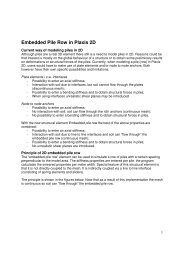
A special option exists for the analyses of pre-stressed ground anchors and excavation supports. The behaviour of these elements is defined using an axial stiffness and a maximum force. Values of interface friction angle and adhesion are generally not the same as the friction angle and cohesion of the surrounding soil.Įlastoplastic spring elements are used to model anchors and struts. For example, these elements may be used to simulate the thin zone of intensely shearing material at the contact between a tunnel lining and the surrounding soil. Joint elements are available to model soilstructure interaction. Hinges may be introduced to create joints where plate ends can rotate freely, or with rotation springs for connections that are neither pinned nor fully fixed. Plates with interfaces may be used to perform realistic analyses of geotechnical structures.Ī hinge is a connection that allows for a discontinuous rotation in the point of connection (joint). A plastic hinge may develop for elastoplastic plates, as soon as the ultimate moment is mobilised. The behaviour of these elements is defined using a flexural rigidity, an axial stiffness and an ultimate bending moment. Special plate elements are used to model the bending of retaining walls, tunnel linings, shells, and other slender structures. Quadratic 6-node and 4th order 15-node triangular elements are available to model the deformations and stresses in the soil. The mesh may contain thousands of elements. Plaxis allows for fully automatic generation of unstructured finite element meshes with options for global and local mesh refinement. From this geometry model, a 2D finite element mesh is easily generated. The input of soil layers, structures, construction stages, loads and boundary conditions is based on convenient CAD drawing procedures, which allows for a detailed modelling of the geometry cross-section.

In addition, since soil is a multi phase material, special procedures are required to deal with hydrostatic and non hydrostatic pore pressures in the soil.Īlthough the modelling of the soil itself is an important issue, many projects involve the modelling of structures and the interaction between the structures and the soil. Geotechnical applications require advanced constitutive models for the simulation of the non linear, time dependent and anisotropic behaviour of soils and/or rock.


 0 kommentar(er)
0 kommentar(er)
